
1Z0-148 Exam Questions & Answers
Exam Code: 1Z0-148
Exam Name: Oracle Database: Advanced PL/SQL
Updated: Nov 13, 2024
Q&As: 243
At Passcerty.com, we pride ourselves on the comprehensive nature of our 1Z0-148 exam dumps, designed meticulously to encompass all key topics and nuances you might encounter during the real examination. Regular updates are a cornerstone of our service, ensuring that our dedicated users always have their hands on the most recent and relevant Q&A dumps. Behind every meticulously curated question and answer lies the hard work of our seasoned team of experts, who bring years of experience and knowledge into crafting these premium materials. And while we are invested in offering top-notch content, we also believe in empowering our community. As a token of our commitment to your success, we're delighted to offer a substantial portion of our resources for free practice. We invite you to make the most of the following content, and wish you every success in your endeavors.

Download Free Oracle 1Z0-148 Demo
Experience Passcerty.com exam material in PDF version.
Simply submit your e-mail address below to get started with our PDF real exam demo of your Oracle 1Z0-148 exam.
![]() Instant download
Instant download
![]() Latest update demo according to real exam
Latest update demo according to real exam
* Our demo shows only a few questions from your selected exam for evaluating purposes
Free Oracle 1Z0-148 Dumps
Practice These Free Questions and Answers to Pass the Oracle Database Exam
View Exhibit1 and examine the structure of the EMPLOYEES table.
View the Exhibit2 and examine the PL/SQL block that you execute for displaying the last name and hire date of the employees in department ID 60.
Which statement is true about the outcome?
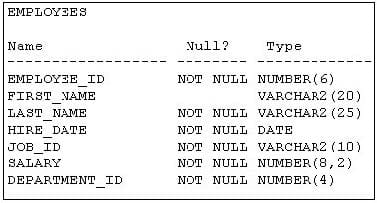
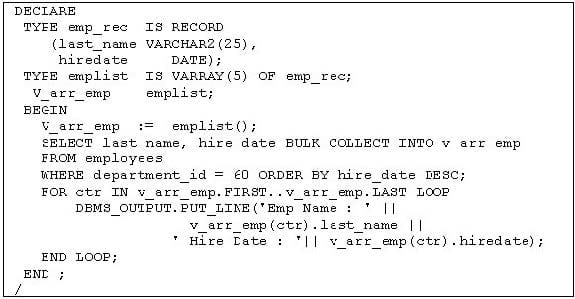
A. It generates an error because RECORD type cannot be used with varrays.
B. It generates an error because BULK COLLECT cannot be used with varrays.
C. It executes successfully only if department ID 60 has five or less than five employees.
D. It executes successfully even if department ID 60 has more than five employees by dynamically extending the varray.
Which two statements are true about the working of fine-grained access? (Choose two.)
A. Security policies can be associated only with tables, but not with views.
B. Different policies can be used for SELECT, INSERT, UPDATE, and DELETE statements.
C. User statements are dynamically modified by the Oracle server through a security policy function.
D. Fine-grained access control policies always remain in effect until they are dropped from a table or view.
Examine the following settings for a session:
PLSQL_CODE_TYPE = NATIVE
PLSQL_OPTIMIZE_LEVEL = 3
Which statement would be true in this scenario?
A. The compiler would automatically inline subprograms.
B. The compiler would inline the code for external subroutines.
C. The compiler would inline the code even if the INLINE pragma is set to NO.
D. The compiler would not inline the code unless the INLINE pragma is set to YES.
View the Exhibit and examine the structure of the EMPLOYEES table.
Examine the following PL/SQL block:
DECLARE
TYPE EmpList
IS VARRAY(2) OF employees.employee_id%TYPE NOT NULL;
v_employees EmpList := EmpList();
BEGIN
DBMS_OUTPUT.PUT_LINE(v_employees.COUNT);
v_employees.EXTEND;
v_employees(1) := 30;
END;
/
Which statement is true about the outcome on executing the above PL/SQL block?
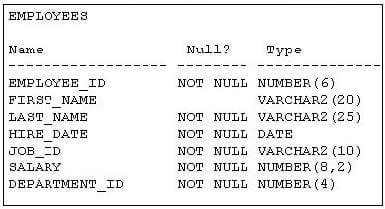
A. It executes successfully and displays the value 2.
B. It executes successfully and displays the value 0.
C. It generates an error because EXTEND cannot be used for varrays.
D. It generates an error because the declaration of the varray is not valid.
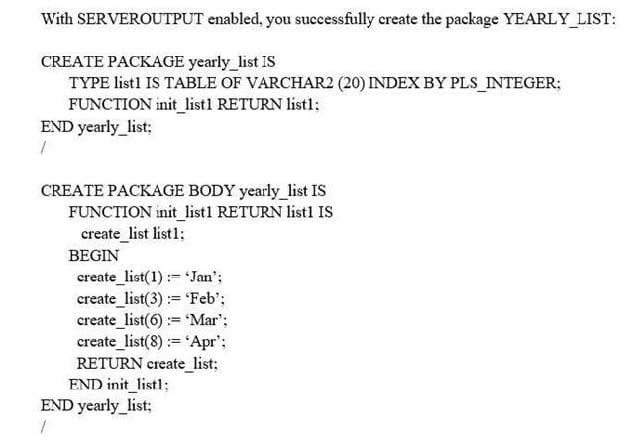
Examine this code:
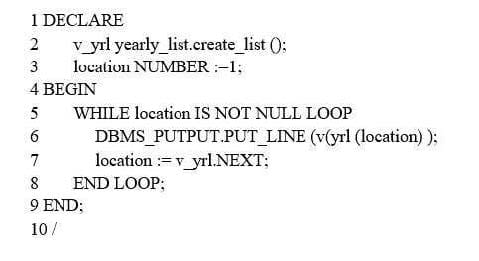
You want to display the contents of CREATE_LIST.
Which two lines need to be corrected in the PL/SQL block?
A. Line 2
B. Line 3
C. Line 5
D. Line 6
E. Line 7
Viewing Page 1 of 3 pages. Download PDF or Software version with 243 questions

